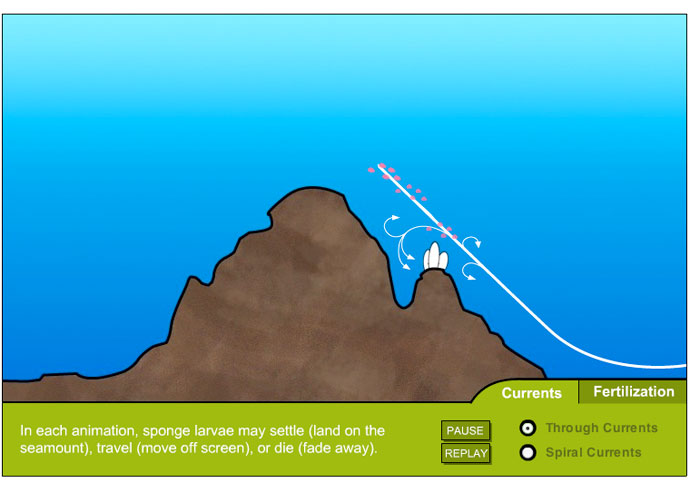Sex and the Seamount Sponge
Many of the invertebrates that live on seamounts spend the majority of their lives firmly attached to the bottom or crawling slowly across it. But for most there is a planktonic larval stage at the beginning of their lives, a time to swim or to be swept along in the currents that flow around and between seamounts. With this freedom comes great peril. Set loose in the vastness of the deep sea, the larvae have just several hours to perhaps a few months to find a suitable place to settle down, metamorphose, and spend the rest of their lives.
Research into the reproductive and dispersal strategies employed by seamount organisms is still in its infancy. A number of physical and biological variables appear to affect the dispersal of seamount larvae. One is maturity at release. Some sponges fertilize their eggs internally, and release fully developed larvae. Others discharge their eggs and sperm, and fertilization and larval development take place in the open sea. A second variable is current flow. Some seamounts are swept by strong currents that flow around and over them with only modest disruptions. Others develop a complex current flow that spirals up and then sinks down above their summits. These current patterns may change seasonally.
In this activity, you will explore how fertilization behavior and current flow influence the dispersal of sponge larvae.
Instructions: Click through the images below to see how larval behavior varies with current patterns and with the timing of fertilization. Then answer the questions that follow.
Questions
- Describe larval dispersal in the presence of through currents. What happens to the larvae in spiral current situations?
[Check Answer]
When larvae are released into through flowing currents, a few settle down on the same seamount but most are carried away. When larvae are released into spiral currents, a few drift off of the seamount but most settle down on its summit and sides. In both cases, a number of them die before they settle.
- Describe larval dispersal when fertilization occurs inside the sponge. What happens to the larvae when fertilization is external?
[Check Answer]
When fertilization is internal, larvae settle down quickly, in the vicinity of the parent sponge. Most of the larvae that arise from external fertilization move away from the adult sponge before settling. Quite a few die while still planktonic.
- Discuss the benefits and drawbacks of rapid vs. delayed settlement to an individual sponge.
[Check Answer]
A larva that settles rapidly is most likely to find favorable growing conditions, since it will be in the same area that sustained the adult sponge that produced it. It will have to compete for food and space with more established sponges and with other larvae, however. A larva that is carried away into the open sea has a good chance of traveling into areas that are not suitable for survival, but may benefit from less competition if it does settle successfully.
- Which conditions would lead to the widest dispersal of larvae, and which to the least?
[Check Answer]
Larvae that are fertilized externally will likely remain planktonic longer than those that are fertilized internally and released at a later stage of development, so they will have more time to travel before settlement. If they are also released into through currents, they have the means to be swept long distances. Internally fertilized larvae shed into spiral currents will have the most limited dispersal.
- What are some of the pros and cons of short distance and long distance dispersal to a population or species of sponge?
[Check Answer]
Short dispersal will help ensure that the maximum number of larvae settle in favorable growing conditions. Dense clusters of sponges can make reproduction easier for species with external fertilization, by increasing the concentration of eggs and sperm in the water. However, large populations concentrated in a small area are more prone to disease and are vulnerable to environmental changes.
A species whose larvae disperse widely will lose many individuals in the process, but it will have the opportunity to colonize new areas and spread out geographically. This will lessen the dangers posed by local ecological disruptions.
Critical Thinking
How might the geologic history of a seamount or seamount chain influence the larval dispersal strategy practiced by its inhabitants?Scientists seek to understand and explain how the natural world works. Many of the questions raised in this endeavor have no absolute answers.
Seamounts are undersea volcanoes. Many of them form close to plate boundaries, where geologic activity is frequent and often violent. Their first inhabitants would predominately be creatures that have traveled some distance. While eruptions and earthquakes and other types of sudden and severe activity are common, seamount faunas will be repeatedly established, obliterated, and then reestablished from distant sources. Organisms that spread their larvae widely will be most likely to colonize and then to produce surviving offspring. Over time, as tectonic activity eases, habitats become more persistent and more restrictive larval strategies become viable as well.
Related Links
Multimedia Discovery Missions: Lesson 15 - Seamounts


